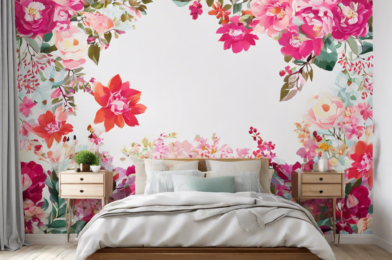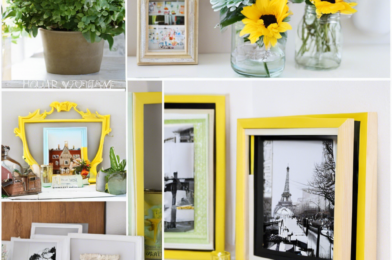**First Paragraph:**
There’s something truly special about adding a unique and creative touch to your living or working space. Wall murals are an increasingly popular way to do just that, offering an affordable and impactful DIY project for homeowners and renters alike. Whether you’re an artist looking to showcase your talent or a beginner wanting to try something new, creating a stunning DIY wall mural is an achievable goal with a bit of guidance and planning. This article will take you through the process step by step, offering tips and tricks to ensure your project is a success. From choosing the right design to preparing your wall and selecting the best materials, we’ve got you covered. So, get ready to transform your space and create a mural that will impress and inspire!
**Second Paragraph:**
The first step to creating a stunning DIY wall mural is choosing the right design. Consider the space you want to work with and the overall vibe you’re going for. Are you looking for something bold and dramatic, or perhaps a more subtle and elegant design? There are endless options to choose from, including geometric patterns, nature-inspired scenes, abstract shapes, or even inspirational quotes. You can also opt for a custom design that holds personal significance. Once you have a general idea, you can start gathering inspiration by browsing online resources, design websites, or even creating a mood board to help visualize your concept.
**Third Paragraph:**
After finalizing your design, it’s crucial to prepare your wall properly to ensure a smooth and long-lasting finish. Start by cleaning the wall thoroughly to remove any dirt, dust, or grease. Fill in any holes or cracks with a suitable filler and sand the surface to create an even canvas. Next, apply a primer, especially if your wall has never been painted before or has a distinct texture or color that might interfere with your chosen mural design. A good primer will not only help your paint adhere better but also provide a neutral base for true color representation. Allow ample time for the primer to dry before you begin painting your mural.
**Fourth Paragraph:**
Choosing the right materials for your DIY wall mural is essential for achieving the desired look and ensuring the durability of your artwork. Select a paint type that is suitable for your specific wall surface, whether it’s drywall, concrete, or wood. Acrylic paint is a popular choice for murals due to its vibrant colors, quick drying time, and easy cleanup. However, if you’re painting on a textured surface or want a more subtle matte finish, a latex or emulsion paint might be a better option. Consider investing in quality paintbrushes and rollers of various sizes to achieve precise details and smooth coverage.
**Fifth Paragraph:**
Before you begin painting, it’s a good idea to create a grid system on your wall to ensure accurate placement of your design. Measure the height and width of your wall and divide it into equal sections. Transfer these measurements to your design and draw a corresponding grid, making sure to number each square. This technique will allow you to enlarge or reduce your design to fit the wall perfectly. You can then use a level and a pencil to lightly mark the grid on the wall, providing guidelines to follow as you paint. This method ensures that your mural stays proportionate and helps you maintain the correct perspective.
**Sixth Paragraph:**
Once your design is gridded and transferred to the wall, it’s time to start painting! Begin with the largest areas of color and work from the top down to avoid smudging or dripping on already painted sections. If you’re using multiple colors, try to plan your painting sequence to minimize the need for constant cleaning of brushes or switching between colors. However, don’t let the paint dry on your brushes or rollers, and always keep a damp cloth nearby to wipe off any excess paint or mistakes. Take your time and work systematically, referring to your design often to ensure you’re staying true to your vision.
**Seventh Paragraph:**
As you paint, it’s essential to maintain clean lines and avoid messy edges. Use painter’s tape to mask off areas that require straight lines or to protect adjacent walls or trim from accidental paint splatters. Remove the tape immediately after you’ve finished painting a section to prevent the paint from drying and pulling off along with the tape. For curved or irregular shapes, you can cut your own custom stencils from cardboard or cardstock, ensuring crisp and precise edges. Take advantage of various brush sizes to navigate tight corners or intricate details, and don’t be afraid to use a small artist’s brush for the tiniest elements of your design.
**Eighth Paragraph:**
If your design includes text, such as a favorite quote or lyrics, take extra care to ensure the letters are flawlessly executed. Again, using a grid system and stencils can be incredibly helpful for achieving straight and evenly spaced letters. Another technique is to print out your chosen font in the correct size and use carbon paper to transfer the letters onto the wall, providing a guide to paint over. Remember that less is more when it comes to text – a simple and legible font will have more impact than a fussy or overly intricate script.
**Ninth Paragraph:**
Incorporating textures into your mural can add depth and a tactile dimension to your design. This can be achieved through various techniques, such as sponging, stippling, or applying paint with a rag or crumpled paper. Experiment with different tools and materials to create unique effects and consider using textured paint additives for more pronounced results. You can also play with shadows and highlights to give the illusion of depth, using lighter and darker shades of the same color to accentuate certain elements or create a three-dimensional feel.
**Tenth Paragraph:**
Once your mural is complete, it’s essential to protect your artwork with a suitable sealant or varnish. This will not only enhance the colors and provide a unified finish but also make your mural more durable and easier to clean. Choose a sealant designed for wall murals or a clear, non-yellowing varnish with UV protection to prevent fading. Follow the manufacturer’s instructions for proper application, typically involving a light sanding between coats to ensure a smooth finish. A quality sealant will extend the lifespan of your mural, keeping it looking vibrant for years to come.
**Eleventh Paragraph:**
Step back and admire your hard work – you’ve earned it! Creating a DIY wall mural is an incredibly rewarding project that can transform your space and showcase your unique style. Don’t be afraid to experiment, embrace your creativity, and remember that practice makes perfect. If you’re pleased with the result and want to showcase your handiwork, why not share it on social media? You might even inspire others to embark on their own mural adventures! So, snap some photos, post them online, and enjoy the well-deserved compliments that are sure to follow.
**Twelfth Paragraph:**
DIY wall murals are a fun and accessible way to express your creativity and personalize your space. Whether you’re an experienced artist or a novice, the process of designing and executing a mural can be immensely satisfying. Remember to plan and prepare thoroughly, take your time during the painting process, and don’t shy away from adding unique touches that reflect your style. With these tips and a bit of dedication, you’ll be well on your way to creating a stunning mural that you can proudly display and enjoy for years. Happy painting!









